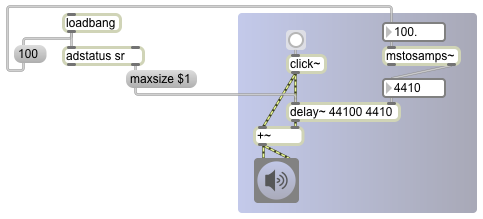The delay~ object creates a “ring buffer” into which it constantly records the signal coming in its left inlet. The first typed-in argument specifies the size of the buffer, in samples. The second argument (or a number in the right inlet) specifies how many samples in the past delay~ should look for the signal it will send out its outlet. So, assuming a sample rate of 44100 Hz, this patch creates a one-second buffer and instructs delay~ to send out the sound it received 1/10 of a second ago.
Entering those values as typed-in arguments makes a rather unsafe assumption about the sample rate. (The sample rate could be 48000 or 96000 or whatever the user has set it to.) A better way to make sure you’re allotting the correct amount of memory and specifying the correct delay time is to use an [adstatus sr] object (which can be triggered by loadbang to report the sample rate) to calculate the size of the buffer in samples (in this case we know we want 1 second’s worth of memory, so we can use the sample rate directly), and use the mstosamps~ object (which will make its calculation based on the current sample rate) to convert the desired delay time from milliseconds to samples.
When the click~ object receives a bang it sends out a single sample with a value of 1; it sends out all 0 values otherwise. That’s a very clearly defined moment in time (known as an “impulse”) that lets you confirm that delay~ is doing what it’s supposed to do.

